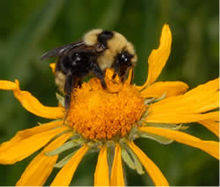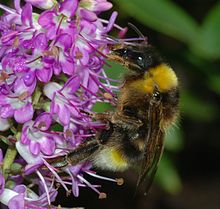- Psithyrus
-
Cuckoo bumblebees 
Bombus insularis Scientific classification Kingdom: Animalia Phylum: Arthropoda Class: Insecta Order: Hymenoptera Family: Apidae Subfamily: Apinae Tribe: Bombini Genus: Bombus Subgenus: (Psithyrus) Species see text
Cuckoo bumblebees are members of the subgenus Psithyrus in the bumblebee genus Bombus. Up until recently, the 29 species of Psithyrus were considered to constitute a separate genus.[1] They are a specialized lineage which has lost social behavior, and lost the ability to collect pollen, and are instead cleptoparasitic in the colonies of other bumblebees. Before finding and invading a host colony, a Psithyrus female (there is no caste system in these species) will feed directly from flowers. Once she has infiltrated a host colony, the Psithyrus female will kill or subdue the queen of that colony and forcibly (using pheromones and/or physical attacks) "enslave" the workers of that colony to feed her and her developing young. When the young emerge, they leave the colony to mate, and the females seek out other nests to attack.
Female cuckoo bumblebees will aggressively attack host colony members, and sting the host queen, but will ignore other animals (including humans) unless disturbed.
Selected species
- Bombus ashtoni
- Bombus barbutellus
- Bombus campestris
- Bombus citrinus
- Bombus cornutus
- Bombus fernaldae
- Bombus insularis
- Bombus rupestris
- Bombus sylvestris
- Bombus variabilis
- Bombus vestalis
References
- ^ Williams, P.H. 1994. Phylogenetic relationships among bumblebees (Bombus Latr.): A reappraisal of morphological evidence. Systematic Entomology 19: 327-344.
Further reading
- Michener, C.D. (2000). The Bees of the World. Johns Hopkins University Press.
- Macdonald, M. & Nisbet, G. 2006. "Highland Bumblebees: Distribution, Ecology and Conservation." HBRG, Inverness, www.hbrg.org.uk. ISBN 0-9552211-0-2.
This bumblebee-related article is a stub. You can help Wikipedia by expanding it.

